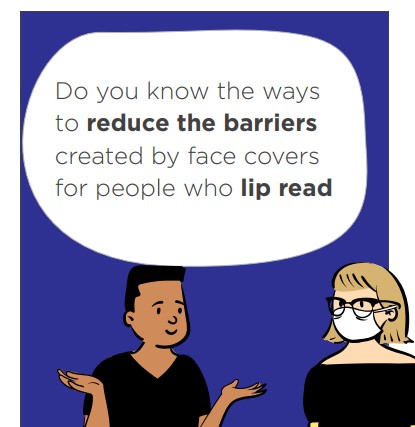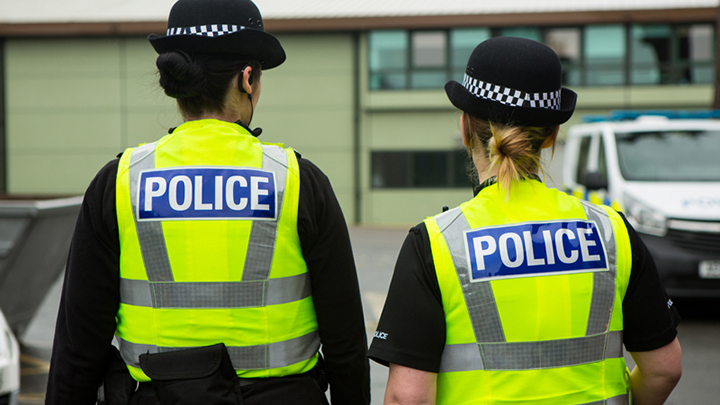
Last month officers across England and Wales began to receive new fabric face coverings - thanks to work led by PFEW. We wanted to ensure that officers were able to follow government guidelines on wearing face coverings and to ensure that they, and members of the public, felt safe while interacting.
However, we know that, for some, trying to understand someone who is wearing a face mask is incredibly difficult and can leave them feeling more isolated and scared at an already difficult time. That is why PFEW has been working with Action on Hearing Loss, one of the UK’s leading charities for those living with deafness or hearing loss, to bring officers tips for communicating while wearing a face covering.
Many people who are deaf or have hearing loss rely heavily on visual cues for effective communication including facial expressions and lip-reading. Being able to see lip patterns and facial expressions is also vital for those who communicate through British Sign Language. Words which sound similar but have different meanings become very difficult to distinguish. This can lead to a breakdown in communication.
Belinda Goodwin, Police Federation of England and Wales’ Wellbeing Secretary, said:
"It is vital that police officers are aware of the needs of, and know how to communicate effectively with, people who are deaf or have hearing loss during this challenging period. As officers are advised to wear face masks if social distancing is not an option and coverings become mandatory in a growing number of places, we appreciate how much more difficult it must be for people who rely on facial expressions and lipreading.
“Working alongside Action on Hearing Loss UK, we have been able to promote advice on what to bear in mind when interacting with affected members of the public. We are especially keen on encouraging officers to download live speech-to-text apps on their mobile devices and reminding them to spot the signs of any physical or mental illness, impairment, or disability preventing a person from being able to wear a face covering.
"Our colleagues always want to do their very best to help the communities they serve, so anything that can help them do this even better will be warmly welcomed.”
Roger Wicks, from Action on Hearing Loss England said:
“Too often people living with deafness and hearing loss find that society isn’t deaf aware. For people with hearing loss to be able to go about their daily lives it is now even more important that everyone, especially those providing frontline services to the public, considers how they communicate with each other to be as inclusive as possible. We are happy to be working with the police in order to make sure our communication tips are adopted in order to make communication easier for the communities we support.”
Karen Robson, from Action on Hearing Loss Wales added:
“Where face masks are worn and lipreading isn’t possible then police officers and the general public can still follow a number of simple communication tips: speaking clearly and slowly whilst using plain language, using assistive devices such as hearing loops and microphones and reducing the amount of background noise. If this still proves difficult then people should be prepared to write information down for those with hearing loss.”
Communication tips for the general public:
- Remember that people who are D/deaf or have hearing loss have individual communication needs and you should ask someone how best you can communicate with them. Not every tip below will be appropriate for every person who is D/deaf or has hearing loss.
- Be patient and considerate, it is a stressful time for us all, but people with deafness and hearing loss who rely on facial expressions and lipreading are finding things especially difficult right now.
The below are particularly important when someone cannot use visual cues, such as on the telephone or when wearing a mask:
- Make sure you are facing the person you are talking to and speak clearly - avoid shouting, speaking too fast or unnecessarily slow
- If someone doesn’t understand you, repeat what you said or phrase it differently, use plain language
- In a noisy place, move to a quieter area if possible
- Use simple gestures such as pointing or waving to get someone’s attention.
- Write things down – use pen on paper, text on device screens, or whiteboards
- If they ask, speak to a relative or friend
Useful tools:
- There are live speech-to-text apps available, though with varying levels of accuracy depending on background noise and speed of conversation.
- Utilise Video Relay Services, such as InterpreterNow, for British Sign Language users
- Use the Sunflower or Hidden Disability Lanyard available in some supermarkets and public spaces such as railway stations.
General communication tips for someone with hearing loss:
- Make people aware that you are deaf or have a hearing loss and your preferred communication style
- Make sure they face you
- Make sure you can see their face clearly (where lip reading is possible)
- Make sure the person gets your attention before they start speaking
- Ask them to speak normally and not exaggerate their lip movements
The below are particularly important when someone cannot use visual cues, such as on the telephone or when wearing a mask:
- Ask them to speak clearly
- Ask them to repeat or say things differently if you do not understand what they have said
- Reduce background noise as much as possible by moving to a quieter space if possible
- Use assistive devices like remote microphones with hearing aids to improve the quality of speech over background noise
- Write things down – use pen on paper, text on device screens or whiteboards
- If possible, ask them to speak to a relative or friend
More information on face coverings, including the latest guidance and sample exemption cards can be found here.
For more information on communicating with those living with deafness or hearing loss, visit Action on Hearing













